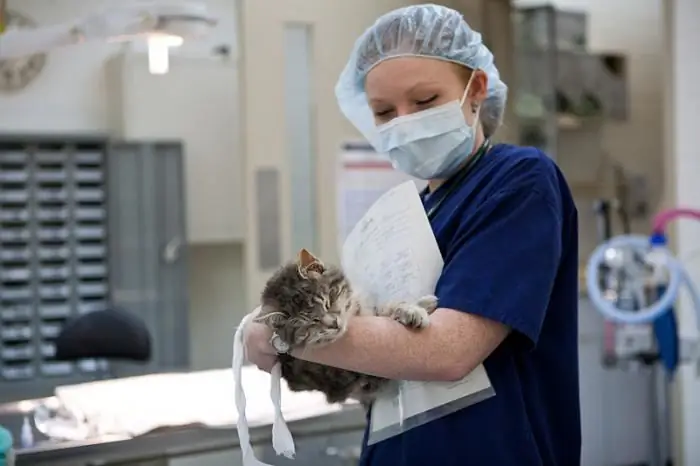2025 Author: Priscilla Miln | [email protected]. Last modified: 2025-01-22 17:55:27
Probably, every owner, having a pet, thinks about whether to preserve his ability to reproduce offspring or sterilize him. On the one hand, sterilization is not a very humane method, since you deprive the animal of the functions laid down by nature itself. On the other hand, this is a fairly simple operation, which rarely causes complications, but immediately solves a lot of issues. This is, first of all, a seasonal change in the behavior of the animal, its runaways from home, as well as pregnancy and feeding of a puppy bitch. Also important is the question of finding owners for puppies, as well as their maintenance and feeding. As you can see, sometimes it is much easier to dare an operation once, but to rid yourself of many problems forever. However, today we would like to comprehensively consider such a problem as the sterilization of dogs, its pros and cons, as well as find out the opinion of veterinarians.

When should the idea of sterilization be abandoned
First of all, if you take a thoroughbred pedigree dog that has every chance of winning in the show ring. Such individuals are very expensive, and, of course, it makes sense to use them for breeding in order to obtain purebred offspring. If you need a friend, then it is not so important whether he has a pedigree and what titles his relatives had. Therefore, long before you get a pet, think about what plans you have associated with it, so that later there will be less disappointment.

What a future owner needs to know
Try to seek advice only from competent cynologists or veterinarians. By asking for advice from your comrades on the paddock, you run the risk of listening to various speculations that are not true. In particular, the opinion is very often conveyed among dog lovers that a bitch, for her he alth, must definitely whelp at least once in her life. In fact, this is a completely baseless assertion. Moreover, if the owner of an adult dog over six years old heard it and, frightened, decided not to delay any longer, such late births are fraught with much more serious complications than spaying dogs. Only a competent doctor should tell the pros and cons of this procedure, so do not trust the he alth of your pet to non-professionals.
The second common myth is familiar to dog owners. You will definitely be strongly advised to untie the dog as soon as possible, so that he acquires a heavier frame, becomes stricter in guarding the house, that is, from a cheerful puppy he turns into a formidable and stern guard. In fact, mating will not help here, males usually mature after two years, and the skeletondepends solely on genetic characteristics. But you will definitely have more problems. An unleashed male will search for a female all his life, tiring the owner with the pursuit of any bitch. Therefore, if such individuals are not breeding animals, from which it is important to obtain offspring, then sterilization of dogs will be a good way out for you. We will consider the pros and cons in detail so that you have a good idea of the consequences of your decision.
The main advantages of sterilization for the owner of the bitch
Of course, every loving owner worries about his pet and wants to collect all the information about the upcoming operation. This is the right approach, because we alone are responsible for those we have tamed.
So, sterilization of dogs, the pros and cons of the operation. Of course, first of all, the decision must be made by the attending physician on the basis of an examination of the animal and a conclusion about its state of he alth. What are the advantages if the decision is made in favor of the operation?
First of all, the problems associated with the dog's pregnancy and subsequent childbirth disappear. And, what is especially important, the owner will not have to think about what to do with unwanted offspring (in modern realities it is difficult to say what will be more humane - to destroy or "give it to good hands", dooming many to a homeless life). The financial aspect is also important. The operation is not free, but it saves the owner from caring for a pregnant and whelping bitch and puppies, which is much more expensive.

Animal behavior
Walking outside is getting muchcalmer, males lose interest in the sterilized individual, as her estrus stops. The risk of developing breast tumors is several times reduced. This is not the only he alth problem that this operation can solve. In some cases, this reduces the risk of various diseases of the genital organs, including malignant neoplasms, to almost zero. Veterinary clinics in Moscow perform this operation at the highest level, eliminating the possibility of complications. It will be especially effective if carried out before the first estrus.
An additional plus is always noted by city dwellers. Breeding puppies in a cramped apartment is a very difficult task, and therefore many easily agree that it is much better to avoid such an experience, and the most effective way is to sterilize dogs. The price of this operation is not so high, everyone can afford it. In addition, this measure immediately solves the problem of cleaning up after the bitch during estrus.

The main advantages of sterilization for the owner of a dog
Actually, the term "operation" can only be applied to bitches. Sterilization of dogs may not be cavitary when it comes to males. In this case, the whole procedure is reduced to the removal of the testes. After the rehabilitation process is over, the animal becomes less susceptible to attacks of aggression, which means that it will be less likely to fight with relatives and get injured. You can no longer be afraid of venereal sarcoma, which is sexually transmitted andleads to the formation of tumor growths.
A sterilized male will not run away from home on instinct, and the owner will not have to look for him. There is no need to quarrel with neighbors, the dog becomes calm after sterilization, it does not howl and does not rush about in search of a partner, does not urinate in the wrong places, practically does not react to relatives suitable for a walk.
General plus for dogs of both sexes: spaying increases your pet's lifespan by almost 20%. Moreover, in some cases it is noted that almost until death the dog remains playful and mobile. If you do not want to be professionally bred, give your pet 3-4 extra years of life, because they do not have much time to measure.

Sterilization as a social necessity
Today the problem of abandoned and homeless animals is particularly acute. The shelters, organized by donations from the townspeople, cannot accept all four-legged animals that need help. Therefore, animal advocates carry out actions on a regional scale, catching stray dogs, sterilizing and treating them, and then releasing them back. Booths are set up in some yards, and local residents feed their inhabitants together. Is sterilization of dogs humane in this case? The pros and cons are obvious. Of course, this does not solve the problem, the animal remains on the street, but it will not bring puppies twice a year, which means that the population of stray animals will become smaller, not larger.

Contraindications for sterilization
Despite the apparent ease, this procedure is a surgical intervention that leads to irreversible consequences. Veterinary clinics in Moscow offer you a full range of services, from primary diagnosis and examination to postoperative rehabilitation. If you turn to professionals, the recovery process after the intervention will pass quickly enough, but the doctor will definitely warn you about a number of contraindications.
Due to the structure of the body, there are breeds for which this operation can result in serious complications. Usually they include pugs and bulldogs. Carefully choose an experienced surgeon, he will be able to tell you in detail what is the sterilization of dogs. The price in this case is not a guarantee that you will be able to avoid complications. The doctor will have to evaluate medical contraindications, take into account cardiovascular insufficiency and impaired renal function, therefore, animals over 5 years of age are primarily at risk.
It is highly not recommended to perform this operation during pregnancy and estrus, lactating bitches. There must be serious indications for a doctor to undertake sterilization under the conditions described.

The main cons that a loving owner should know about
Like all surgical interventions, spaying of dogs also has its drawbacks. Reviews of many owners say that the most unpleasant consequence is urinary incontinence. Indeed, this happens quite often, and this complication develops some time after the operation, so that, at first glance, it is not associated with it. In fact, everything is easy to explain if we turn to physiology. The uterus and ovaries are removed from the abdominal cavity, which forms a cavity into which the bladder is displaced. As a result, diseases of the urinary system of varying severity develop. In addition, hormonal changes also contribute to the development of this complication. But for the most part, this is true for dogs of large breeds, weighing more than 30 kg. Hormonal changes, in turn, lead to the development of obesity, so now you will need to carefully monitor your pet's diet.
The operation itself is a risk factor. The seam in a dog after sterilization can fester or disperse, there is a risk of bleeding and infection, inflammation, and hernia. We must not forget that sterilization is carried out under general anesthesia, which puts a strain on the pet's body. The heart is especially at risk. Finally, there is evidence from cynologists that conditioned reflexes in sterilized dogs are developed somewhat worse, which means that you need to think about when to sterilize a dog.
Surgical spaying of bitches often has minimal he alth risk and no additional complications. But for a male, this operation always leads to violations in the he alth of the dog, regardless of the age at which the operation was performed.
Optimal age
For medicalindications, this operation can be done throughout the life of the pet. However, if we talk about the prevention of diseases and pregnancy, as well as the correction of behavior, it becomes clear that it is better to expose young dogs to it. And this is where opinions differ. They veterinarians believe that it is optimal to do it to puppies at 2 months of age. Others argue that in this case, the development of the pet slows down, growth lag is possible, as well as learning difficulties. Therefore, it is believed that it is best to prepare an animal for surgery that is 12 months old. It is at this age that dogs are best sterilized. The age of one year is usually marked by the first estrus, just after it ends, you can go to the vet.
After surgery
We have already touched on the cost of the operation. In clinics in Moscow, you will pay for it from 1000 to 2000 rubles, which is not so expensive, given all the advantages that sterilization of dogs gives. Caring for a pet after surgery is quite troublesome, you will have to be patient. You have to do dressings every day, monitor the condition of the animal. If you notice suppuration or an unpleasant smell under the bandage, this is an occasion to immediately go to the doctor. The animal may be lethargic for the first few days, but if the pet completely refuses to eat, this is also an alarming sign.
As the dog's condition returns to normal, it's time to get life back on track. So, again you need to walk a lot and be sure to eat right. It is best to make rice, white meat and fish the basis of nutrition after the operation. Stitches are usually removed at 10-12day after the operation. By this time, minor physical activity is already allowed. Then life smoothly returns to its usual course.
What to look out for
Even a professional doctor cannot always foresee all the nuances, so it is quite rare, but complications do occur. What should alert after the sterilization of dogs has been performed? Estrus is nonsense for a sterile bitch, but such phenomena do occur. This suggests that the operation was carried out with some violations. An ultrasound of the abdominal cavity is necessary so that conclusions can be drawn about the condition of the pet and the necessary further treatment. Sometimes there is another phenomenon: a sterile bitch continues to knit. This also speaks of the unprofessionalism of the doctor who performed the operation. Therefore, before entrusting the life and he alth of your pet to doctors, collect reviews about doctors and clinics, weigh the pros and cons, and only then draw conclusions.
Recommended:
Dog: the pros and cons of keeping, choosing a breed and advice from owners

What you should know before purchasing a puppy. About the pros and cons of a dog in the family. Which breed is suitable for a family with children, for beginner dog breeders and for becoming a companion. What questions should you ask yourself to determine the right breed. Video advice from a veterinarian. About raising a dog, choosing a method of feeding, keeping in an apartment and in a private house
Cons and pros of IVF: description of the process, advantages and disadvantages, medical advice

Not all couples are lucky enough to have children. But modern medicine has stepped far forward, and now it is possible to solve the problem of infertility with the help of IVF. The article lists all the pros and cons, tells about what indications and contraindications for this method can be, about how the fertilization process takes place
Jumpers: pros and cons (Komarovsky). Jumpers: pros and cons

Jumpers: for or against? Komarovsky believes that it is better to buy an arena, because jumpers are harmful to he alth. Is it really?
Sterilization of a cat: care after surgery. Pros and cons of sterilization

Remember the phrase from Anouin de Saint-Exupery's The Little Prince: "We are responsible for those we have tamed"? But what will a loving and caring owner choose: a calm, long life of a pet without he alth problems or the ability of an animal to remain “full”?
Sterilization of a cat: the pros and cons. When is the best time to spay a cat?

Pet owners often face the problem of procreation of their pets. The most appropriate solution to this issue is the sterilization of the cat. The pros and cons of this operation should be studied in advance in order to eliminate negative consequences

